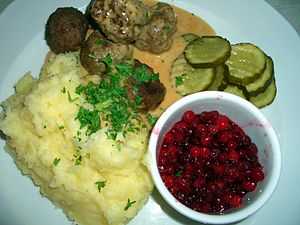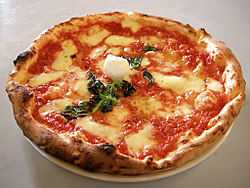European cuisine, or alternatively Western cuisine, is a generalised term collectively referring to the cuisines of Europe and other Western countries,[1] including (depending on the definition) that of Russia,[1] as well as non-indigenous cuisines of Australasia, Latin America, North America, and Oceania, which derive substantial influence from European settlers in those regions. The term is used by East Asians to contrast with Asian styles of cooking.[2] (This is analogous to Westerners' referring collectively to the cuisines of East Asian countries as Asian cuisine.) When used by Westerners, the term may sometimes refer more specifically to cuisine in Europe; in this context, a synonym is Continental cuisine, especially in British English.
The cuisines of Western countries are diverse by themselves, although there are common characteristics that distinguish Western cooking from cuisines of Asian countries[3] and others. Compared with traditional cooking of Asian countries, for example, meat is more prominent and substantial in serving-size.[4] Steak in particular is a common dish across the West. Western cuisines also put substantial emphasis on grape wine and on sauces as condiments, seasonings, or accompaniments (in part due to the difficulty of seasonings penetrating the often larger pieces of meat used in Western cooking). Many dairy products are utilised in the cooking process, except in nouvelle cuisine.[5] Wheat-flour bread has long been the most common source of starch in this cuisine, along with pasta, dumplings and pastries, although the potato has become a major starch plant in the diet of Europeans and their diaspora since the European colonisation of the Americas. Maize is much less common in most European diets than it is in the Americas; however corn meal, or polenta, is a major part of the cuisine of Italy and the Balkans.
Central European cuisines
[6][7]
| Slovakian Skalický trdelník |
|
Eastern European cuisines
| Romanian Sărmăluţe cu mămăligă |
|
Northern European cuisines
| Danish Stegt flæsk med persillesovs |
|
Southern European cuisines
Western European cuisines
| Belgian carbonnade flamande |
|
See also
References
Further reading



 Austrian cuisine
Austrian cuisine Czech cuisine
Czech cuisine German cuisine
German cuisine Hungarian cuisine
Hungarian cuisine Polish cuisine
Polish cuisine Slovak cuisine
Slovak cuisine Slovenian cuisine
Slovenian cuisine British cuisine
British cuisine
 Danish cuisine
Danish cuisine Estonian cuisine
Estonian cuisine Faroese cuisine
Faroese cuisine Finnish cuisine
Finnish cuisine Icelandic cuisine
Icelandic cuisine Irish cuisine
Irish cuisine Lappish cuisine
Lappish cuisine Latvian cuisine
Latvian cuisine Lithuanian cuisine
Lithuanian cuisine Norwegian cuisine
Norwegian cuisine Swedish cuisine
Swedish cuisine Albanian cuisine
Albanian cuisine Bosnia and Herzegovina cuisine
Bosnia and Herzegovina cuisine Bulgarian cuisine
Bulgarian cuisine Croatian cuisine
Croatian cuisine Gibraltarian cuisine
Gibraltarian cuisine Greek cuisine
Greek cuisine
 Italian cuisine
Italian cuisine
 Neapolitan cuisine
Neapolitan cuisine Sardinian cuisine
Sardinian cuisine.svg.png) Sicilian cuisine
Sicilian cuisine Tuscan cuisine
Tuscan cuisine Venetian cuisine
Venetian cuisine Occitan cuisine
Occitan cuisine Macedonian cuisine
Macedonian cuisine Maltese cuisine
Maltese cuisine Montenegrin cuisine
Montenegrin cuisine Portuguese cuisine
Portuguese cuisine Serbian cuisine
Serbian cuisine Slovenian cuisine
Slovenian cuisine Spanish cuisine
Spanish cuisine
.svg.png) Belgian cuisine
Belgian cuisine Dutch cuisine
Dutch cuisine French cuisine
French cuisine
 Liechtensteiner cuisine
Liechtensteiner cuisine Luxembourgian cuisine
Luxembourgian cuisine Swiss cuisine
Swiss cuisine










































